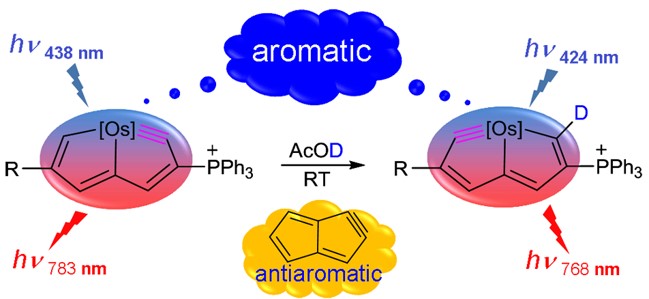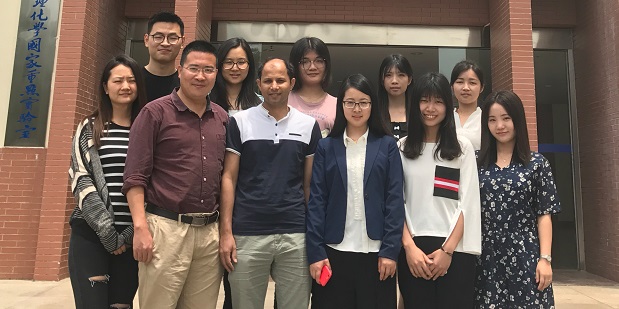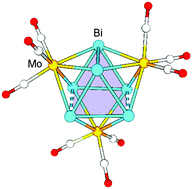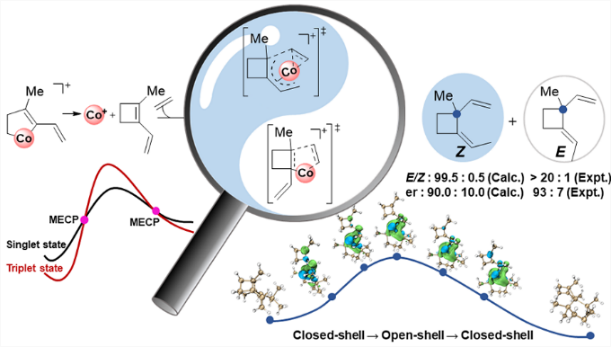Nature Chemistry





The first Zintl cluster containing a distorted Bi6 triangular prism, [Bi6Mo3(CO)9]4−, has been synthesized and structurally characterized. Quantum chemical calculations indicated that the distorted cage cluster features multiple local σ-aromaticity.
https://pubs.rsc.org/en/content/articlelanding/2021/CC/D1CC00734C#!divAbstract

The cyclobutane unit is important to prepare complex natural products with biological activity due to the high ring strain. Among various approaches, [2 + 2] cycloaddition is one of the major strategies to prepare cyclobutane under light conditions. Recently, Rajanbabu's group reported tandem catalysis for asymmetric coupling of inactivated ethylene and enynes to functionalized cyclobutenes or cyclobutanes. However, the reaction mechanisms remain unproven.

Aromaticity and hyperconjugation are two fundamental concepts in organic chemistry. By combination of the two concepts together, the resulting hyperconjugative aromaticity has attracted considerable attention from both theoretical and computational chemists. However, previous studies are mainly focused on the main group chemistry. For the hyperconjugative aromaticity in the transition metal chemistry, the studies are limited to groups 10 and 11.

The Ni‐B complex 1BCF with a facilely accessible monophosphine (PtBu3) unit was theoretically designed, which was found to be more active than that with an ambiphilic ligand for hydrogenation of styrene. Substituting PtBu3 with a stronger electron donating ligand N‐heterocyclic carbene largely improves the activity of the Ni‐B complex.

Disilene has attracted considerable interests due to the trans-bending geometry which is significantly different from the planar alkene. However, the equilibrium between disilene and isomeric silylsilylene has not been fully understood. Here, we report a density functional theory (DFT) study on this equilibrium. Calculations reveal significant effects of substituent, aromaticity and base. Specifically, the parent disilene is thermodynamically more stable than the isomeric silylene.

While sp2-hybridized carbon atoms in hydrocarbons typically contribute only one electron to their aromaticity, metals have more electrons from d or f orbitals available for participating in conjugation in organometallics, complicating the electron counting as well as analysis of their aromaticity. Here, the author comments on the challenges towards understanding aromaticity in organometallics and outlines several remaining questions that have yet to be answered.

Selective cleavage of the B–O bond or B–H bond in HBpin can be achieved by adjusting the pincer ligand of a phosphorus(III) compound guided by a combination of theoretical prediction and experimental verification. Theoretical calculations reveal that a pincer-type phosphorus compound with an [ONO]3– ligand reacts with HBpin, leading to cleavage of the stronger B–O bonds (ΔG°⧧ = 23.2 kcal mol–1) rather than the weaker B–H bond (ΔG°⧧ = 26.4 kcal mol–1).

The σ-bond activation by main group element has received enormous attention from theoretical and experimental chemists. Here, the reaction of C-X (X = Cl, Br, I) bonds in benzyl and allyl halides with a pincer-type phosphorus(III) species was reported. A series of structurally robust phosphorus(V) compounds were formed via the formal oxidative addition reactions of C-X bonds to the phosphorus(III) center. Density functional theory calculations show that the nucleophilic addition process is more favorable than the direct oxidative addition mechanism.

The isolated‐pentagon rule (IPR) is a determining structural feature accounting for hollow fullerene stabilization and properties related to Cn (n ≥ 60) cages. The recent characterization of an unprecedented non‐IPR hydrofullerene, C2v‐C66H4, bearing two heptagons with adjacent fused‐pentagons motif, largely dismiss this feature. Herein, employing DFT calculations, we explore the 13C‐NMR pattern and aromatic behavior of C2v‐C66H4.

Activation of dinitrogen (N2, 78%) and dioxygen (O2, 21%) has fascinated chemists and biochemists for decades. The industrial conversion of N2 to ammonia requires extremely high temperatures and pressure. Here we report the first example of N2 and O2 cleavage by a uranium complex, [N(CH2CH2NPiPr2)3U]2(TMEDA), under ambient conditions without an external reducing agent. The N2 triple bond breaking implies a U(III)-P(III) six-electron reduction. The hydrolysis of the N2 reduction product allows the formation of ammonia or nitrogen-containing organic compound.
Copyright © 2025,
Theme Originally Created by Devsaran
